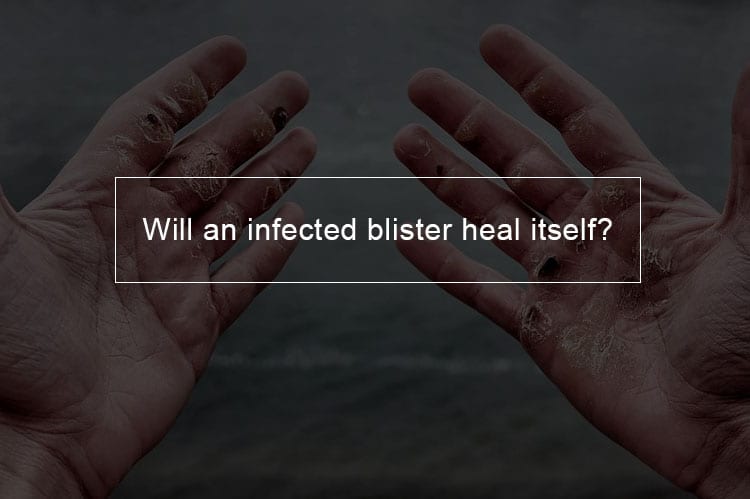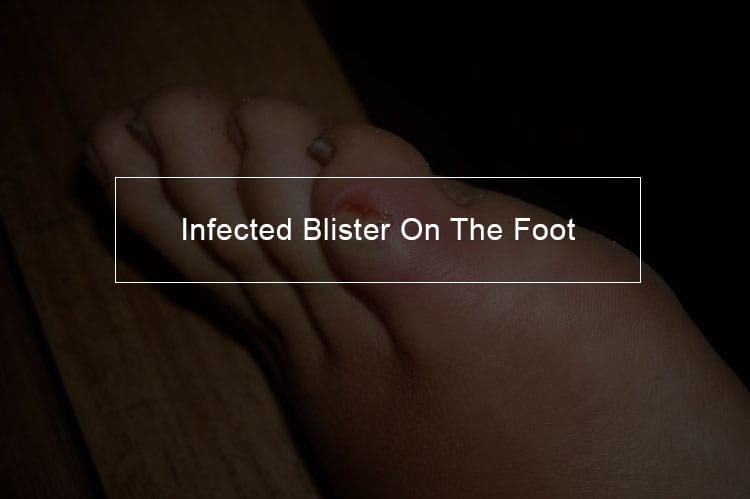
Whether they develop on the hands, feet, knees or any other part of the body infection is always a concern. It is even more significant concern when the infection results from a blister. If you have ever broken in a pair of shoes or worked in the garden, you are probably familiar with getting blisters. The human body can fight most of the infections, but if you are dealing with an infected blister can it succeed to fight it? Whether you are currently suffering or you are merely concerned, it is good to know if your blister is infected and how to treat it. Read through the article to find out how to manage an infected blister.
How can you tell if a blister is infected?
How to tell if a popped blister is infected?
With other skin problems, it is easy to know if a blister is infected since they fill up with an unknown liquid. Nevertheless, blisters appear to be prefilled with their juices, so it can be difficult to tell if a blister is recovering or not.
Blisters can arise in any part of the human body, but they mostly occur on hands and feet. A common cause of blisters is the friction from footwear rubbing on the skin over prominences on foot. However, some skin diseases present themselves with blisters too.
Before we look at the signs of an infected blister, it is essential we understand how a normal blister looks like. The top of a normal blister has a shielding layer and the fluid within acts as a cushion cellular and platelet factors. The fluid is typically clear or straw colored and could be filled with blood. The blister top keeps the fluid you, and it is rare for the blister to become infected if it remains intact.

What does an infected blister on the foot look like?
The following are the basic symptoms of a blister on the foot and other body parts:
- If your blister looks or feels different from a usual blister description, it could be infected.
- Redness or tenderness in the skin around the blister is a sign that the blister is infected.
- If your blister starts looking like pus, then it is infected .
- A crust could also form on an infected blister.
- Watch out for red streaks starting to radiate away from the blister, or the surrounding skin becomes red, swollen and hot or experiencing fever or chills as this could mean cellulitis development. This means that the sepsis is transmitting to your blood and other systems. You should see a doctor immediately.
Infected blister of the swollen foot
An infected foot is usually painful and can make it hard to walk. An infection can happen after an injury to your foot. Bacteria can enter in a wound, such as a cut or a skin crack and cause an infection.
Swelling, change of color and the formation of blister are a possible sign of an infected foot. However, symptoms of an infected foot depending on the cause. Medical orders such as diabetes mellitus and ingrown toenails can cause your feet to be infected.
Foot blisters are clear fluid pockets which form under the skin. They are a worldwide issue usually caused by too tight shoes. Foot blisters can get infected and needs immediate treatment. You can develop blisters on your foot or between your toes. The following are the common symptoms of an infected foot blister.
1. An infected foot blister may discolor. White, flaky patches between the toes are a sign for athlete’s and can be mistaken for blisters.
2. The skin around the affected area of the foot may feel warm to touch if the blister is infected. Beware that this is a potential sign of cellulitis.
3. Swelling from inflammation can be limited to the infected area such as the toe of the foot with the infected blister. The swelling can also spread to the entire foot. Foot swelling can make the skin look shiny or waxy.
4. Fever is a common sign of foot blister infection.
5. There could be fluid or pus drainage from the infected foot if you have an abscess.
Causes of an infected blister on the foot
Foot blisters usually form after an injury or wound to the foot. Having certain medical conditions also increases the risk of blister foot infection. The following are the common causes of foot infections. Fungal infection can cause blistering between toes. Athlete’s foot is the most usual fungal infection. The infection thrives in feet which have been damp for prolonged periods.
People who have diabetes have an increased risk of foot infections including the blistered foot. Over time, high blood sugar can cause harm to the skin, blood vessels and nerves in the feet. This condition makes it hard to feel minor blisters, which can become ulcers eventually and get infected. A wound such as cuts, scrapes, and cracks in the skin on your feet can enable bacteria to enter and cause infection, including blisters infection.
An individual can also develop a blister as a result of surgery. The risk of developing a foot infection after surgery is minimal, but it is a possible complication after fix of a fractured foot or ankle. Antibiotics are given to individuals after surgery to reduce the risk of such an occurrence. Contacts with chemicals such as detergents can also cause blisters.
What happens if a blister gets infected?
What if a popped blister gets infected?
As discussed above an infected blister will be filled with yellow or green pus and may be painful, red and hot. One should not ignore an infected blister because it could result in infectious bacterial infection of the skin and further difficulties, such as cellulitis. See a doctor if you have blisters in particular areas such as your eyelids or inside your mouth or if you have severe symptoms such as sunburn, or allergic reaction.
How to prevent getting a blister formation on foot and hands?
To avoid getting blisters or blisters infection, there are a handful of things you can do. For example, you can:
1. Wear comfortable and well fitting shoes
2. If you do gardening, wear work gloves to prevent blister formation
3. Use sunscreen
4. Keep your feet dry by wearing thicker socks
Can infected blisters heal on their own?
How long does it take for a blister to heal?
Most blisters heal naturally after three to seven days and may not require medical attention. It is essential to avoid bursting the blister as this could cause an infection or slow down the healing process. If the blister burst, do not peel off the dead skin. But, allow the fluid inside the blister to drain and cover the area with a dry, sterile dressing to shield it from infection until it heals. However, if you need to pop a blister follow the following process:
1. Sterilize a needle in red hot flame or rinse it with alcohol.
2. Clean your hands and the area rigorously, then make a small hole.
3. The blister substance will evacuate on itself. White or yellow blister fluid indicates the blister is infected and needs medical attention.
4. Avoid removing the skin over a broken blister since the new skin underneath will be lacking the protective cover.
5. Smear antibiotic ointment or cream
6. Watch out for signs of infection to develop, such as pus drainage, warm skin around the blister or redding of the skin.
So will infected blister go away on its own? I all depend on how long you want to keep the infection. If you're going to get rid of the infection early, then you have to seek medical help rather than natural healing.
Similarly, if you do not like the idea of having a blister scar, it is essential to see a doctor for treatment. If blisters are not checked well, they might leave unwanted scars. However, if the infected blister is on sensitive areas such as the face, it is essential to see a doctor. Do not wait for the blister to heal itself. You might consider buying antibiotics if the blisters are on the face but leave natural healing for areas which are not sensitive such mas abdominal areas.
How to speed up blister healing process?
The following practices should help you the infection from getting more severe:
- If the blister has not popped leave it alone; endure the pain.
- Submerge the affected foot in warm water to help the blister drain on its own.
- If the blister is a spot that gets pressure, such as at the bottom of the foot, you might want to cushion the region with a piece of moleskin. The moleskin will relieve some comfort.
- Allow your blister to breathe by exposing it to air. If the blister is on foot, take care of it and ensure it does not get dirty.
- Use natural remedy such as aloe vera gel to help the blister heal more quickly. Apply the oil on the blister and bandage it.
- You may also soak the blister in apple cider vinegar, to speed up the healing process of the blister or apply tea tree oil on the blister.
How do you treat an infected blister?
Infected popped blister treatment
If you think that your blister is infected, consult your physician as soon as possible. Many different things can cause infections, so that he may do a skin biopsy. In this process, your physician takes a small tissue sample and analyzes it to determine its underlying cause. After the doctor has a better idea of what is causing the infection, they might prescribe:
- Oral or topical antibiotics
- Oral or topical antifungal medications
The might also do a quick in-office process to drain the blister. It is essential that you leave this treatment to your physician. Doing the procedure on your own can make the infection worse or cause it to spread to nearby areas. While you wait to visit a doctor, there are several things you can do at home to relieve your signs and fight the infection:
- Clean the blister- Run the area under warm water and gently massage it with soap. Keeping washing and rinsing for about five minutes. Repeat at least twice a day.
- Soak the blister- Soak your wound in a homemade saline solution. You can make this by adding one teaspoon of salt to one cup of warm water.
- Treat the wound- After washing both your hands and the wound, apply a topical antibiotic ointment such as Advil, Bacitracin, and Neosporin.
If left untreated, severe infections can begin to spread to other areas of your body. Besides, bacteria can enter the blistered skin and cause cellulitis. Cellulitis is a rapidly spreading skin infection. It can quickly become a case of emergency if it spreads to the bloodstream and lymph nodes.
Infected blisters can also lead to severe cases. This happens when certain chemicals released by your immune system trigger a chain in your body. Eventually, this can lead to septic shock. However, most people recover from milder cases of sepsis.




